Fin’s nephews, Hugh Barkley and Leslie Patton Barkley came to Yuma to work Fin’s homestead for him. Hugh was the older and he came around 1910. Les was younger and came to Yuma around 1918, but he had knocked around the world some, serving in the Merchant Marine. He also had a brief stint in the Golden Gloves boxing competition, and according to family stories, did very well. He did indeed enjoy the occasional sociable fist fight, something that was more acceptable in the early years of the twentieth century than nowadays.
Anyway, Les and Hugh got to work, built a tent house (a house with a wooden foundation and floor, ½ way wood walls and then canvas sides and roof) on the homestead and began to work at leveling the land with a mule team and a Fresno scraper. Some of the land they worked belonged to Fin’s cousins the Zehs, and there is a section of farm still named Zeh today. The Yuma Valley was a lot different in aspect then. It was filled with mesquite scrub, arrow weed, puncture vines, creosote bush, many sand hills, and boggy areas, since the Colorado River flooded most every spring. There was no electricity, no phone service, hardly any roads and paving was only in the imagination. They started to work in August, and they were young men from northern California, The determination to make a better life still amazes me now. They must have endured such pain and exhaustion and apprehension of what the future would hold.
While Les was working on one of his new fields about 1920, he happened to look up– from baling hay, is the story that’s been told. He saw the school bus stop a ways away and a lovely and graceful young teacher stepped down from the bus. Les was struck by the lightning bolt of love, the first time he laid eyes on Floy Q Taylor. He put all of his determination to work on finding her forthwith and winning her hand. They did marry and lived a long and happy time together.
Floy Taylor had come to Yuma with her family from Weatherford, Texas. She had two sisters, Tessie who died in childhood and Flora, and two brothers, Richard (Dick) and Harold. When she came to Yuma, she had already begun to teach in Texas at the age of 16. In Yuma she taught at Sunnyside School, a one room school, where she had all eight grades in one room, and she was the only teacher. She often told of how she had students who were bigger and older than she. For many years, up until her death at 100 years old in 1999, people would come up to her and talk about their school years and how she had such a wonderful impact on their lives. She was honored by the Arizona/Yuma Teacher’s Association at the Teacher of the Year Banquet in Yuma, ca. 1995, for her contribution to early Yuma County education.
Eventually Hugh left the Yuma Valley to return to Northern California. Les became a successful farmer and cattle rancher. During the Great Depression, he started buying foreclosed and tax delinquent properties. One of his favorite sayings was “Save your money and jingle your rocks, and you’ll always have tobaccy in your ol’ tobaccy box.” Meaning doesn’t show off your money, save it and you’ll always be able to have what you want and need. He’d saved during his youth, and was able to purchase a good amount of land as it became available.
Les and Floy had two children, James Finley Barkley, born in 1925, and Mary Martha Barkley, born in 1928. They raised them first in Somerton, and then in a farmhouse in the south end of the Yuma Valley close to Gadsden. Both of their children attended Gadsden Elementary School and then Yuma Union High School. While Les mainly farmed, alfalfa, wheat and maize and cotton, he also raised cattle and sheep. There was a bunk house behind the small farmhouse where they lived where itinerant cowboys would live while they helped work the herd. The small cattle feed yard on that farm would eventually give on to a very large cattle operation that lasted until the 1960’s.
Both James, called Jimmy, and Mary Martha became excellent riders. They worked with their father on the farm and in the cattle. There was a stable of excellent cow horses, that Jimmy had trained himself. There was one horse that he was particularly fond of and used it every day. When World War II started, a cavalry officer came around the Yuma Valley looking for horses to take to war. When he came to the Barkley farm, Jimmy proudly showed off his horses. The Cavalry officer was so impressed by the way they were trained; he made such a good offer that Jim couldn’t refuse. The officer said he wanted all the horses and in particular Jim’s favorite horse. All the horses went to war, and it Jim always said it was one of the hardest things he ever had to do.
In 1941 Jim was old enough to pursue one of his greatest dreams, and he began a course in flying. That was the year that Pearl Harbor was attacked and the airports within a 150 mile distance from the coast were closed. Jim had to put his flying classes on hold until the end of the war.
He and Mary Martha went to school with a family who were close neighbors. Gen, Louise, David, Polly and Caroline Lott lived a mile to the east of the Barkley farm house. Marion Griffin also was a close friend who lived in the same part of the valley. The Lotts are part of another pioneer family to the Yuma Valley, the Lott-Frauenfelder clan, but that’s a whole other story. They all went to school in Gadsden Grammar School where there were 5 children in Louise’s 8th grade graduating class. She and Jim both went to Yuma Union High School.
When we complain about the heat here, I always think of those families, who worked so hard. They lived in houses that even had no electricity until the end of the 1930’s. Most of them didn’t have evaporative coolers until after the war, and air conditioning was not common in most homes until around 1960. They had no TV, and until electricity came around, no radio. Telephones were installed in the ‘30’s, but each line was shared by several homes. You had to be careful about what you said, because it was likely a nosy neighbor was eavesdropping on your conversation!
In those days, the early and middle part of the 20th century, there were several active social and business clubs. The Cattlemen’s Association and the women’s organization, the Cowbelles, put on community dances at various school houses, such as Rood School, which still exists on Somerton Avenue as a church. There were also community gatherings at the various churches in Somerton and Gadsden, as well as local semi-pro baseball teams, often divided by race! It wasn’t unusual to walk two or three miles to visit a ‘close’ neighbor, and kids would run from one farm to another and their parents would not have to worry about their safety. Kids would begin to drive when they were old enough to clutch and shift, maybe around ten years of age, even if it really wasn’t legal. In fact, one of the neighbor children, Marion Griffin, had his own car, a Packard, when he was nine. Floy Barkley told a story about when Marion and Jimmy were small boys they decided to drive a Model ‘T around. The field in front of the house was leveled and smooth, so they got in the car. Neither one was big enough to steer and clutch at the same time, so one was on the floor working the clutch and the other was standing on the seat of the car steering around and around the smooth field.
A favorite summer job for high school kids was work in the melon sheds. Thousands of acres of cantaloupes and watermelons were grown in the Yuma Valley during the 1930’s. The melon sheds where melons were packed and shipped were built on railroad spurs, mostly in the southern part of the Yuma Valley. Louise and her siblings all worked as melon sticker people and packers. It took a really strong person to load the crates onto the railroad cars and that was done mostly by young men. It was hot work, out on the railroad dock in the middle of summer. It was considered a coup to get to work in the office!
There was only one high school in Yuma then, Yuma Union High School. They all attended. Then graduation ended high school for Jim and Louise. The war had started and Jim had joined the Navy. While Jim headed to Houston to school, Louise went to Tucson and U of A where she received her B.S. in secondary education. Meanwhile, Mary Martha went to Los Angeles to school in UCLA. She majored in the arts with an emphasis on theatre and film. She was perfectly poised to join in the new television industry, and went to work for CBS, where she had a quite successful career. She soon married and had two children, Floy Anne and Leslie Patton. They all became permanent Californians.
Jim was taken into the V-12 program and went to school at Rice University. He graduated only 2 ½ years after he started with a degree in mechanical engineering and a commission as a naval first lieutenant. The V-12 program offered spots to around 150,000 outstanding young men. Because of its high pressure demands, only about half were commissioned. Jim did receive his commission and a degree in mechanical engineering. He was a lieutenant in the Navy, just as the war ended. After the war, Jim returned to Yuma, where he and his longtime friend and neighbor, Louise Lott, struck up a romance. When Jim came back to Yuma from the Navy, Louise was a business teacher at YHS. They decided that they were meant for the girl and boy next door, which of course meant each other, and they married in 1948.
Jim applied for and received a job at General Electric in Chicago, but even as they were packing to go, decided that their best future lay in Yuma. They unpacked and Jim went to work with his father, Les, on the farm. Louise continued to teach at Yuma Union High School until the birth of her daughter, Mary. Eventually Jim and Louise had two more children, Jim Jr., and Robert.
Jim got his pilot’s license, and then he set out to learn all he could about scientific farming. He grew cotton, and was one of the first farmers in Yuma to start to grow winter produce such as iceberg lettuce, broccoli, cauliflower, and green onions. He even grew potatoes on the Yuma mesa for a few seasons. He was especially proud of his cotton, though, and in a time before green cultivation was an issue, learned to grow, with the help of Gabe Piceno, 4 bales per acre cotton. This was in a time when the southern United States was struggling to produce 1 bale per acre. The Colorado River Basin was rich with silt from the river floods and relatively undamaged by over farming. Jimmy learned about NH3, which is ammonia, a necessary nutrient to grow lush crops, as well as other chemical and organic fertilizers and pesticides. This new kind of farming became the basis for agriculture across the US and made it possible to help end soil depletion as well as food and fiber shortages that had plagued farmers. He was one of many pioneers in agriculture whose dedication we all owe much.
Jim also used his mechanical engineering skills to invent many useful machines in his shop. He worked to improve planters and applicators and harvesters. His work in mechanical cultivators, machines that could weed and thin cotton helped to mechanize cotton farming and reduce the toil of workers in the fields. I can remember going out to a cotton field with dad where he had a weeding machine that had a small flame that ran along the row. The idea was that it would only kill the more tender weeds and the woodier cotton would not be harmed. This was a very good idea, but it had to be carefully calibrated or disaster would be the result it the flame got too hot and burned the crop.
During the late 50’s a program called the Bracero program was implemented. This was a contract worker program with Mexico. Many men from the interior of Mexico came up from their homes to Yuma (and to other farms in the US) to work for a period of time. They could then go to their homes, and return to their jobs every few months. On our farm they lived in large barracks about ¼ of a mile from our house. They had a large camp, with a huge modern restaurant style kitchen and dining room. The cooks were expert at cooking hearty food, and had a large tortilla cooker on a moving belt, where they would produce hundreds of tortillas every day. We would often walk down to the camp, ‘to help,’ but actually to get one of the amazing bean burritos that the camp cooks would hand out.
About a mile from the house was a huge feed lot, that at one time held about 10,000 steers. They were worked by Bracero cowboys and even Jim and Louise’s kids. Every once in a while they would stampede out of the corrals and run across the desert. Then we would have to get out the horses and herd up the runaways. Jim developed a very interesting loading runway for the steers so they would be calmer when getting on the trucks to go to market. It was called the sidewinder chute, made of winding concrete walls about 5 feet high. The steers would not be able to see where they were headed, and therefore couldn’t get nervous about boarding the truck. It was a pretty good invention, except sometimes they would get backed up and even upside down in the chute and then they were hard to access and move along!
Every year, Jim (or JFB as he was often called) and Les would host a huge barbeque on the banks of the east main canal south of Somerton. About a month before the party was to take place, the word would be out in Somerton that the Barbeque was being planned and everybody should come on down. Jimmy and Les, as well as Jim’s father-in-law, George Lott, would get together a crew to fix up the huge brick lined barbeque pit. The Barbeque grounds would be scraped and watered, and trees trimmed up. A dance floor and parking lot was fixed, and everything was spiffed up. Then they would usually butcher two steers, three or four sheep, and if someone had a pig, parts of it might make it to the pit, but usually it was beef and lamb. In the days before the party, everybody would have chores, which included buying paper plates and cups and flatware, gathering a ton of mesquite, ordering a whole lot of beer, sodas, and ice. The camp cooks would sort a 100 plus pounds of beans, and as much rice. They would work all through the night before making tortillas and there would be rolls (birrote) from San Luis as well.
Two nights before, the meat would be laid out on huge tables where we all—we kids thought it one of the best things we got to do all year–would rub a special salt rub into all parts of the beef and lamb. The meat was cut into huge 40 lb chunks. Meanwhile, the fire would be started in the pit to begin burning down into charcoal. About 10 pm the night before, the meat would be lowered directly onto huge racks in the pit and then the pit was covered with a steel lid and left to cook all night. The only contact with the cooking meat was a thermometer on a wire that could be removed by way of a tiny door within the larger steel door.
The women—Louise at the helm, Floy, Mary Martha, if she was home, many of the wives of the workers, and our many relatives—would get together at the house where they would make salad, guacamole, salsa, cakes, and roll the flatware in napkins. This was before we had food processors, so it was all very labor intensive.
The morning of the barbeque would bring the mariachi band that had been hired to play. By ten a.m. the guests would start coming in. Usually there would be some coffee or hot chocolate for the kids. By eleven, the line for the food would start to form—the beans and rice, the bread and tortillas, salad, salsa and guacamole would be set out on long, long tables covered with butcher paper. The beer kegs were on ice as were the sodas. Then the men would open the pit, and oh the fragrance is unforgettable. The meat was hauled by pitchfork onto serving trays. Then they would start to carve the meat and about 15 people would get behind the tables to serve the crowd. Usually, there would be about 1000-2000 people who came to enjoy the meal, visit and have fun. Robby said that the last barbeque he and Jimmy put on had more than 2500 people in attendance, more than the Crane School Barbeque.
Then the dancing would start. Gabe and Cora Piceno would usually lead the way, probably better dancers than most on Dancing With The Stars. Gabe’s brother Abe was married to a woman, Amelia Gui, who was known as the Marilyn Monroe of Mexico. She was a famous movie star who had been in many, many Mexican movies. She would come to the parties and the young Bracero men would just line up to get a chance to dance a few steps with her. I’ll bet there are plenty of (by now) old men in Mexico who still remember that as one of the high points of their life. The dancing and by now pretty hard drinking would last until the wee hours of the night. Sometimes the partying and flirting and drinking would break down into one fight or another. One time a man got so enraged, he got a pistol out of his car. Before violence could ensue, thought, Cora Piceno talked him out of his pistol. Most of the time it was just a whole lot of people having fun with friends.
Then as the years passed, farming became more specialized and mechanized. Almost all harvesting became mechanized, and cultivation became modern. When the Bracero program ended, the barbeques became much smaller, more like family gatherings than those huge spectacles. But what fun they were while they lasted. The farm started to grow in acreage, as JFB expanded his business. He bought other farms, and expanded into California and Mexico. In 1971 he formed Barkley Seed and Grain which exists today as part of Barkley Ag. During the decade of the 70’s, JFB grew as much as 8000 acres of lettuce a year for L????? Company and his own company, Alpha Sales,.
Soon Jim and Louise’s kids grew up. They all went to Somerton Grammar School and then to Kofa High School. Mary then went to college at NAU in Flagstaff, and Jim Jr. attended U of A in Tucson. Then Robby, the youngest went to NAU as well. Eventually Mary married John Auza, from another pioneer family, moved to the Wellton-Mohawk valley where they raised sheep and had three children, Hank, Caroline and Chris Auza. Jim joined the Marine Corps after his time in U of A, where he was a lieutenant and travelled to several places. He then went to UC Davis and received his master’s degree in business admin. When Robby finished up at NAU he headed back to Yuma where he began to work on the farm with our father.
In August of 1979, when Jim was 52 year old, he was flying a plane that was his dream plane, a P51 Mustang WW II fighter plane. He headed to Oxnard, where he had a farming operation. When he didn’t show up at the scheduled time, it was feared that he had crashed. One of the largest aviation searches in the history of the southwest ensued, and his plane and body were discovered in the foothills west of Palm Springs. The tragedy was devastating to our family and to many in the community. His funeral service was attended by nearly a thousand people and his memory is still alive for so many people. One thing that always is said of him is that he was a person of huge intelligence and charisma and that no one ever heard him say so much as the mildest of curse words. He was surely one of a kind.
Louise was especially devastated and of course frightened by what the future would hold for her and the farming business. Jim and Louise had just begun to build their dream house and the farming business had grown from a family farm to a far ranging agri-business operation. She was surrounded by a very good group of people who advised her on what her next move should be. George Gallaher and Vic Safranek were the comptroller and accountant at the Ranch Office and knew the business workings thoroughly. Robby was well versed in the workings of the Barkley Seed Company and the farm. There was excellent farm equipment well maintained and organized run by the operations manager Clint Morris, and Gabe Piceno, the grower was the said to be the best farmer in the Yuma Valley.
She also had a family who loved and supported her, her daughter Mary, her son Jim, her sisters Gen Wolfe, Polly Coffeen and Liney Jessen and her brother Davey Lott. She got over being scared, and pulled herself up and went to work at getting on with things.
During this time, Robby married a beautiful young Marine widow, Kathy Conard Jones. She had three great kids, Tim, Kelly, and Toby Jones, who became part of the whole family. A couple of years later, Robby and Kathy had a child together, Michael Barkley, and their family was complete. They were married for many years. Sadly, Kathy succumbed to lymphoma in 2003. She has a great legacy in her children and her talent as an artist.
Barkley Company had some hard years ahead, but with some incredible perseverance, probably born from a history of perseverance in the family, Barkley Company prospered and became strong once again. Robby continues as the head of the company. Hank Auza is the grower and farm manager, Toby Jones runs international shipping and the real estate division, Chris Auza is the harvest manager and runs the computer GPS mapping program, Michael Barkley has a greenhouse business and almond and olive tree groves.
Robby met and married a sweet and very pretty young woman, Rachael Ruben Byrd. She has a daughter, Sammy Byrd. Mary lives in Yuma and Jim lives in San Rafael. Sadly, Louise passed away a few years ago.
Her grandchildren have done well. Hank married Cori Allen, the daughter of a Wellton-Mohawk farming family, and they have two daughters, Harleigh and Zoey, and one son, Hank, Jr. Tim married Evelyn Snell, and they live in L.A., with two children, Tessa and Finley. Caroline has two children, Hayden May and Hannah May and they live in Tucson. Kelly married Dr. Andy Meyer, they have four children, Brynkley, Zander, Haven and Anwyn. They live in Boulder, Co. Toby married Jenny Hardy, whose family has a long history in Yuma, and they have four daughters; Jordan, Olivia, Ella and Claire. Chris and his wife Sam have 4 children; Jr, Annie, Caroline and Barkley. Michael lives in Yuma and is young and still single!
Farming has evolved for the Barkley Family. The farm still produces wheat and cotton and produce, plus a huge variety of winter vegetables, such as leaf lettuces, spinach and celery, as the market calls for them. It will be interesting to see how Barkley Company and the Barkley family evolve with each new generation in Yuma and if they last here until the next 100 years has gone by.
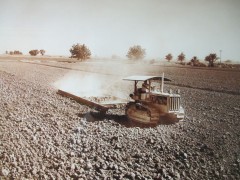
Circa 1948, on Les Barkley’s farm in Somerton, Arizona. Caterpillar diesel D4 tractor with 8’x30’ wooden float, preparing land to plant lettuce. Loose soil was carried by the float until it filled low spots. Level fields conserve water, a concern than as it is today.
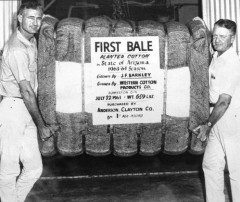
First Bale from the first crop of cotton planted in Arizona during the 1963-64 season weighing 659 lbs., grown by J.F. Barkley.
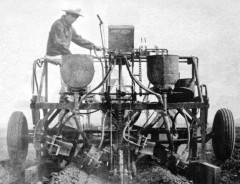
Circa 1974, This system, invented by Jim Barkley, created sidehill bed rows. Cotton was planted on the south side of the row in order to capture more warmth from the winter sun, protect perminating plants from the wind, and lengthen the available growing time for cotton crop.
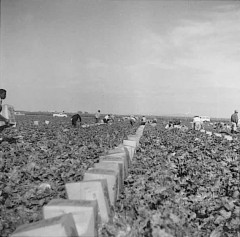
Iceberg lettuce packed by ground crews waiting to be loaded on flatbed trailers and transported back to the cooler where they would be vacuumed cooled and shipped via truck or rail to points east.
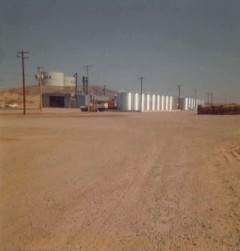
Circa 1970’s, the beginnings of Barkley Seed Incorporated’s mill and processing facility. It is on this site that the company’s seed operation and corporate headquarters are located today. The location has served the Barkley Companies well.
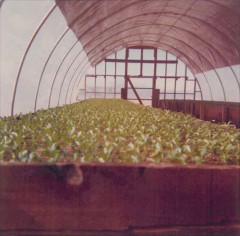
Circa 1970’s, transplanting is becoming increasingly important to the agriculture industry and the Barkley Companies were early adopters to transplanting as a way of utilizing resources in an efficient an sustainable way.
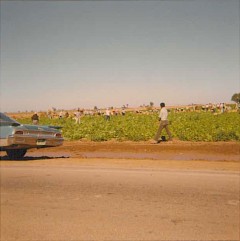
Large team of men harvesting iceberg lettuce in what was commonly known as flat pack method. This photo was taken prior to the advent of harvest machine introduction in the late 1970’s and early 1980’s. This method of packing lettuce was eventually phased out by the early 1990’s.